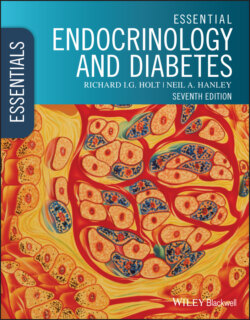Читать книгу Essential Endocrinology and Diabetes - Richard I. G. Holt - Страница 57
Signal transduction
ОглавлениеWhen a hormone binds to a cell‐surface receptor, two major types of signalling cascade unfold inside the cell; protein phosphorylation by kinase enzymes or the generation of ‘second messengers’ via coupling to guanine (‘G’) proteins. Signalling through either process amplifies the hormone response as many protein phosphorylation events or second messenger molecules are produced for each hormone–receptor interaction. These two types of signalling pathway divide the cell‐surface receptor superfamily into two subclasses: tyrosine kinase receptors and G‐protein–coupled receptors (GPCRs) (Figure 3.1 and Box 3.3).
Figure 3.1 The different classes of hormone receptor. Some cell‐surface receptors, e.g. the parathyroid hormone (PTH) receptor, can link to different G‐proteins, which couple to either adenylate cyclase or phospholipase C (PLC). TK, tyrosine kinase; TRH, thyrotrophin‐releasing hormone; GnRH, gonadotrophin‐releasing hormone; TSH, thyroid‐stimulating hormone; LH, luteinizing hormone; FSH, follicle‐stimulating hormone; ACTH, adrenocorticotrophic hormone; PTHrP, parathyroid hormone‐related peptide; PGE2, prostaglandin E2; GHRH, growth hormone‐releasing hormone; IGF‐I, insulin‐like growth factor I.
